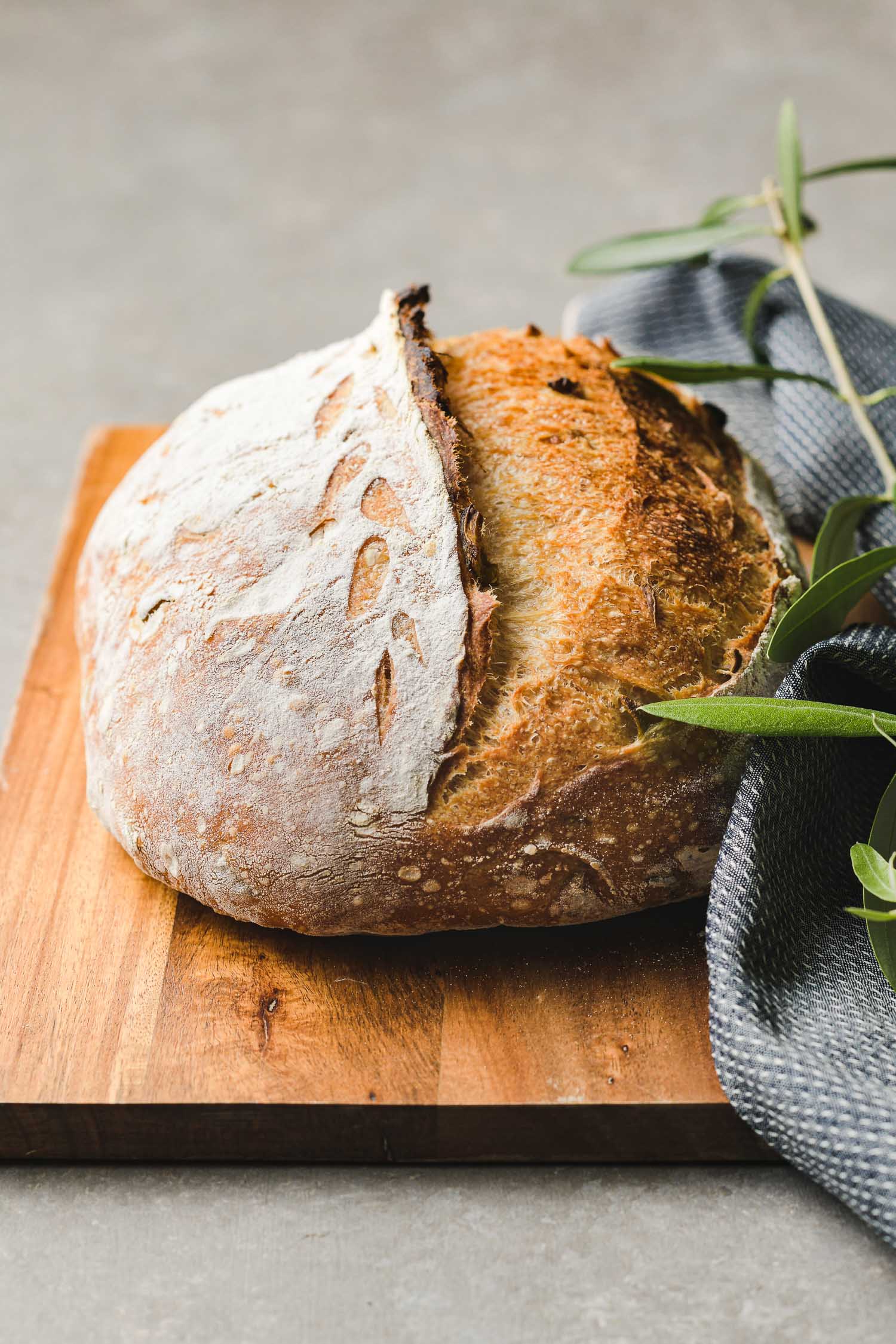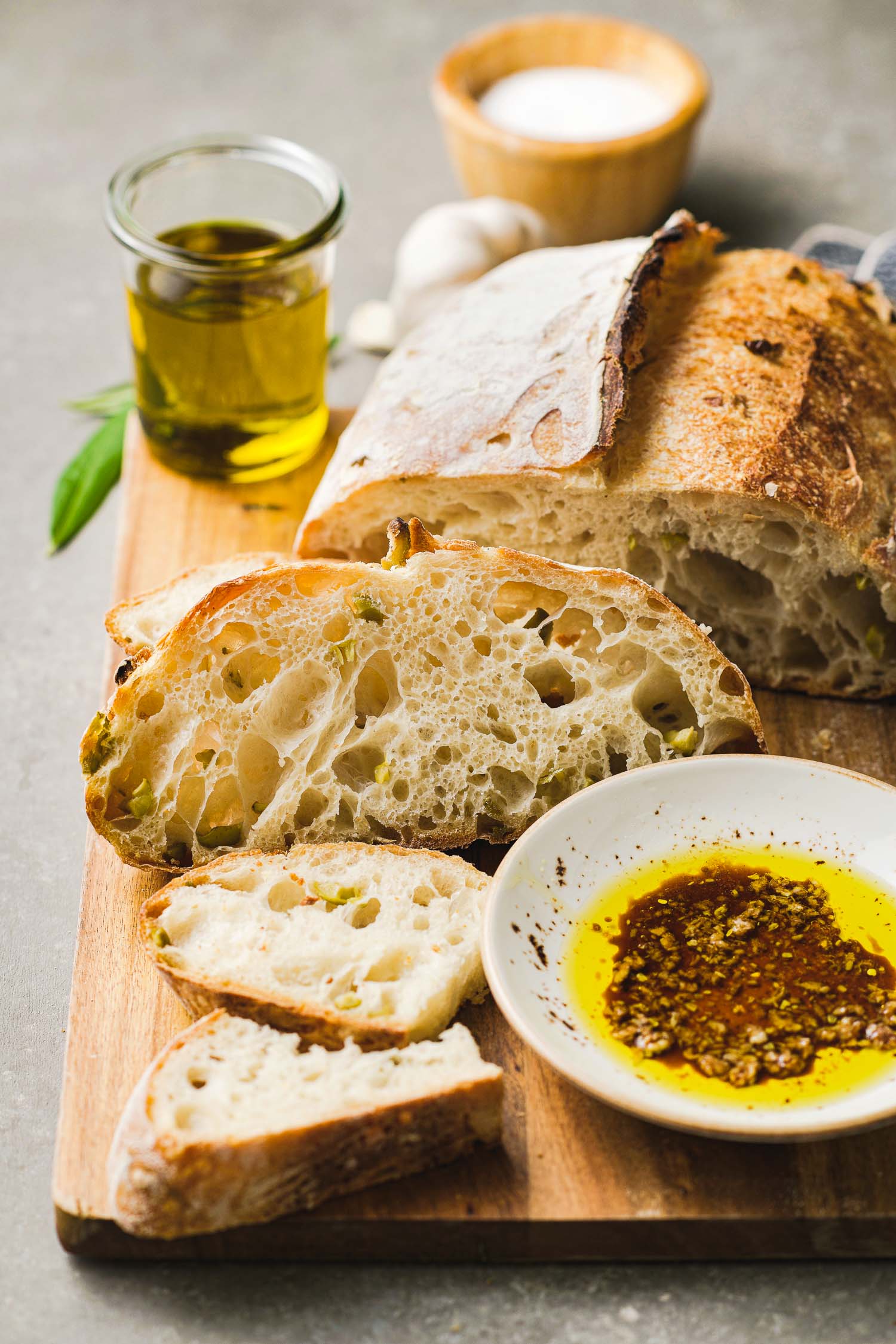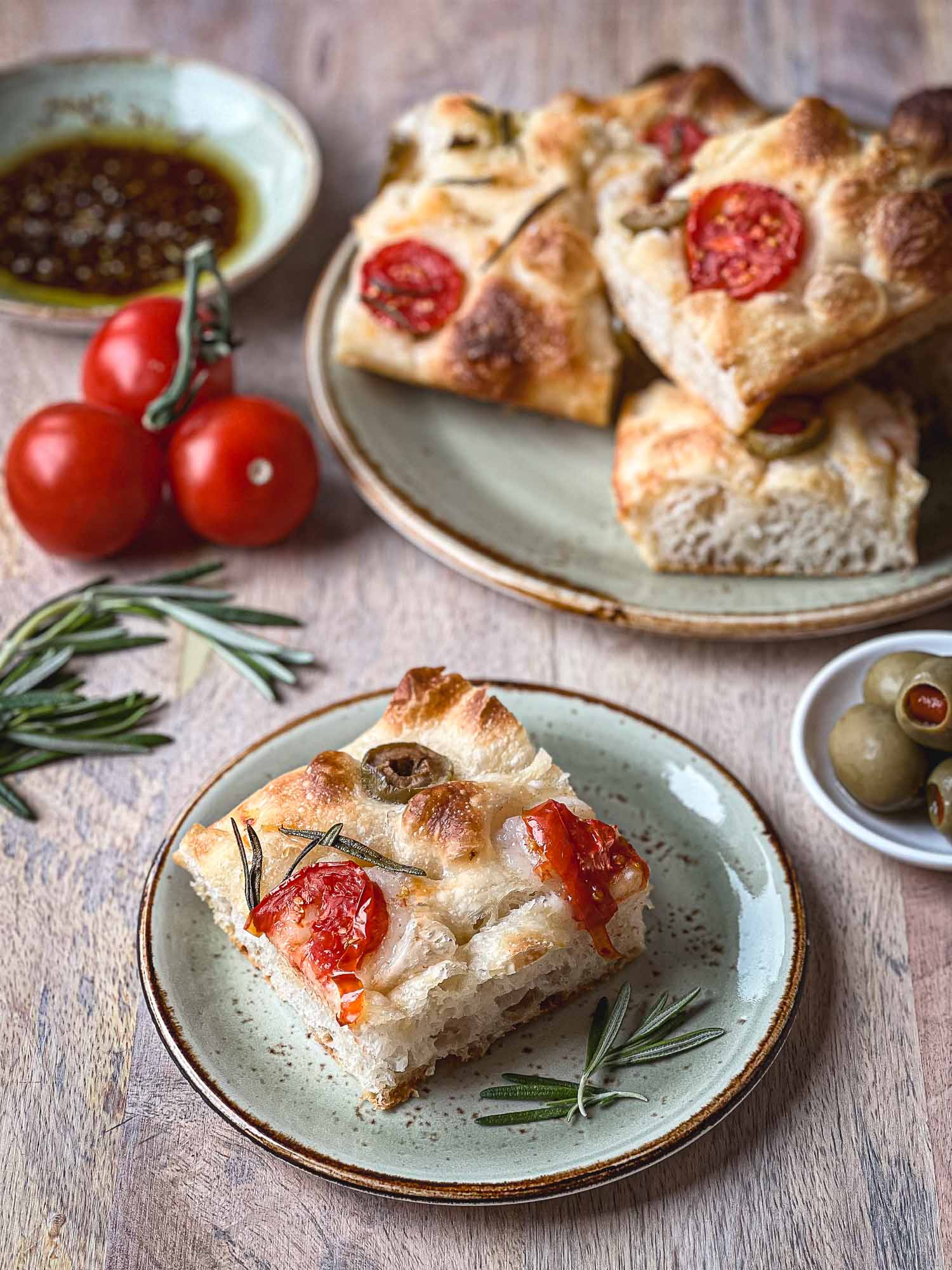Sourdough Olive Bread
If you’re looking to change your sourdough routine, this olive loaf might be the ticket. It makes for the perfect dipping bread but it’s wonderful for sandwiches, too.

Nothing new here–I’ve just been baking bread, as usual. My once-a-week bakes have turned into a three-or-four-times-a -week routine. And since each loaf is started the morning before the day it’s baked, each day has either been spent tending to a batch or two of dough or I’ve been baking a loaf first thing each morning.

I’ve never eaten more sandwiches in my life than I have over the past two months but we’ve enjoyed every bite. And even with our increased consumption we can only go through one or two loaves a week so I’ve been gifting a lot of sourdough bread to friends–no-contact, doorstep delivery even.

Recently, I was inspired to make an olive loaf since olives are one of my favorite add-ins for sourdough bread. Acme Bread Company is one of the Bay Area’s local suppliers of sourdough bread and they make a wonderful olive loaf. I love the briny, slightly salty bite from the olives and it’s one I enjoy in all applications–as a dipping bread, in sandwiches or even for morning toast with butter and honey or jam (love a sweet and salty combo).
I’ve been playing with other flavors, too, and one of the next recipes coming to the blog will be a loaf that I loaded with dried figs and pancetta. And sourdough pizza, wow. I’ll save it for another post, too.
Today it’s all about olives. I’ve used different varieties based on what I have available–mild, California green olives packed in water; salty and briny kalamata olives packed in olive oil–use what you prefer. I like a forward salty bite but my husband likes the mild, buttery flavor from canned olives so I rotate between the two. I’ve also used a combination of both in the same loaf with great results.
If you plan to use this olive loaf as a dipping bread a simple mixture of olive oil, balsamic vinegar and crushed garlic will be all you need to bring extra zing and richness to every bite. Just don’t forget the wine to wash it all down.


Sourdough Olive Bread
If you're looking to change your sourdough routine, this olive loaf might be the ticket. It makes for the perfect dipping bread but it's wonderful for sandwiches, too.
Ingredients
- 330 grams bread flour
- 257 grams filtered water
- 65 grams ripe starter (recently fed and at or close to peak rise)
- 7 grams kosher salt
- 85 grams chopped olives (your favorite variety)
Instructions
-
Day 1, Mix the Dough and Autolyse: In a bowl combine the flour and water and use a spatula or dough whisk to mix the dough until no dry bits of flour remain. Cover the bowl with plastic wrap and autolyse for one hour (autolyse is flexible so you can extend this time to suit your schedule up to a few hours). (Dough temperature: 79ºF)(See Bulk Fermentation section regarding temperature and time.)
-
Add Starter: After autolyse add the starter and incorporate into the dough by folding or kneading it in. Cover with plastic wrap and let sit for 30 minutes.
-
Add Salt and First Stretch and Fold: After 30 minutes add the salt by sprinkling it over the dough and dimpling it in with your fingers (better to wet your hand for this to prevent the dough sticking). You can further incorporate the salt by using this stage to perform your first stretch and fold session. Cover and let sit for 30 minutes. (Dough temp: 80ºF)
-
If time permits, perform a second round of stretch and folds but you can skip this step if you feel you're running short on time.
-
Lamination and add Olives: Carefully turn the dough out on your counter that has been lightly misted with water. The topside of the dough when it was in the bowl will be the bottom when turned out on the counter. Using wet hands carefully take a piece of the dough and pull it gently moving your hands so they're supporting the dough from the bottom. Pull gently from all around the dough until you have a flat, rectangular sheet of dough. Sprinkle about 2/3 of the chopped olives evenly across the top. Take two sides of the short edge of the rectangle and fold it 2/3 of the way over. Sprinkle half of the remaining olives on the folded piece of the dough and take the other short edge and fold over. Sprinkle the remaining olives on the top then fold this piece in thirds again. Transfer the laminated dough seam side down in a square casserole dish, cover with plastic wrap and let sit for 30-45 minutes. (Dough temp: 81ºF)
-
Coil Folds: Using wet hands pick up the dough from the center on each side and lift until one portion of the dough separates from the casserole dish and tuck it under the rest of dough. Rotate and repeat on the other side. Doing this twice. Repeat this coil fold session every thirty minutes until you see your dough gaining more structure between folds. Four coil folds were performed for the loaf pictured here but you may only need three depending on how your dough looks. (Dough temp: 80ºF)
-
Bulk Fermentation: After the last coil fold allow the dough to finish bulk fermentation until it has grown by 30-50%. At temperatures I've noted here the total bulk time for my loaf was four hours from the time I added the starter. It may take a little longer or less time depending on your starter and the temperature in your kitchen. Just watch for bubbles on top of the dough and it should look lighter and airier with rounded edges.
-
Shape and Cold Retard: Dust your banneton (round or oval)with rice flour. Turn the dough out on a lightly floured surface (all purpose or bread flour). The top of the dough now becomes the bottom. Gently pull the dough to flatten it a little, fold in thirds and roll into a ball. Transfer the dough to the banneton seam side up, pinching the seams together. Cover with a plastic bag and refrigerate overnight.
-
Day 2, morning, Bake. Put your dutch oven with the lid on in your cold oven and preheat to 475ºF. When your oven has reached temperature take your dough out of the refrigerator and flip it over on the counter lined with parchment paper. I like to use a small cutting board for this step (parchment paper between the banneton and the board) to make it easier to flip the dough out. Brush the excess flour from the top of the dough and score. Put on your oven mitts and take your dutch oven out of the oven. Remove the lid and gently lay the dough in the pot using the parchment paper. Cover, return to oven and bake for 20 minutes. Reduce the oven temperature to 450ºF, remove the lid and bake for another 10 minutes. Reduce the temperature again to 425ºF and bake for a final 10 minutes. Cool on a wire rack for at least three hours before slicing.










Gorgeous. And if I was there I’d probably grill the bread in butter, or dip into that spicy olive oil. And not be able to stop eating. Which is why I might be the only blogger who did not jump on the sourdough bandwagon starting in March!!!
Oh, the bread grilled in butter sounds wonderful! And you’re right–the whole world seems to be baking with sourdough these days! 🙂
Agree completely with Mimi
That’s exactly why I didn’t jump on the bandwagon last March but now I’m on it and full steam ahead! I’ll try this soon (I told my family, no more Acme bread in this house !)
Hi, Suzanne. Hope you’ve started baking since drafting this comment. Acme bread was a house favorite but I haven’t had to buy it in quite a long time now. We never seem to run out of bread here anymore. 🙂
Hy, 🙂
i’m Daniela… greetings from Romania!
Great work ! wonderful site and amazing recipe !
i just descovered you and i’m just in love with your website and your work
i have jut a problem …i can’t get into your recipe index …it give me an error about debbuging …
anyway i’ll become a true fan of yours
i’ve just pinned all that recipes that i can opened … truly amazing work! 🙂
your new fan
Daniela
Hi, Daniela. I’m so glad you have been enjoying looking through my blog. Unfortunately, the recipe index has been giving me trouble and it needs to be fixed–still working on it. Happy to help you if there are specific recipes you are looking for. You can also use the search bar or the Categories on the sidebar of the main blog page to search. Hope this helps and apologies for the inconvenience!